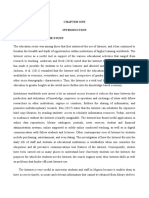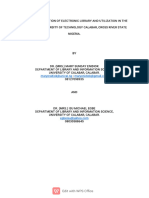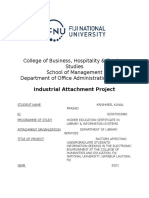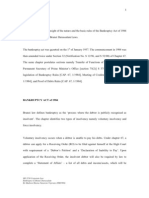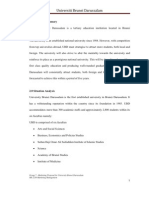Report: E-Library Usage Among UBD Undergraduate Students
Report: E-Library Usage Among UBD Undergraduate Students
Uploaded by
Madison SheenaCopyright:
Available Formats
Report: E-Library Usage Among UBD Undergraduate Students
Report: E-Library Usage Among UBD Undergraduate Students
Uploaded by
Madison SheenaOriginal Title
Copyright
Available Formats
Share this document
Did you find this document useful?
Is this content inappropriate?
Copyright:
Available Formats
Report: E-Library Usage Among UBD Undergraduate Students
Report: E-Library Usage Among UBD Undergraduate Students
Uploaded by
Madison SheenaCopyright:
Available Formats
1
Report: e-Library Usage among UBD Undergraduate Students
Summary
This report aims to find out the extent of the e-Library usage among UBD undergraduate
students, to define the factors that affect its usage and determine the students’ experiences of
the e-library. Questionnaires were designed and distributed to elicit relevant information such
as the student’s age, gender, ease of access to an internet connection and level of usage of the
e-library. It was found that e-library services and facilities being offered by the university is
being utilised only by half of the undergraduate students of UBD. The usage of the e-library
is influenced by factors such as the students’ competence in the use of the technology, its
perceived usefulness and motivation by lecturers. The e-library has proven to be beneficial to
its users.
1. Introduction
With the rapid advances in information and communication technologies, computer-based
activities have been prevalent in almost every institution. Many higher-learning institutions,
including the University of Brunei Darussalam, have adopted ‘e-library’ as a way to
encourage students to be receptive to the new technologies. UBD’s online public access
catalogue, dubbed as the VISION, provides users access to over 2000,000 bibliographic
records through a single connect point whereby information and applications are shared
(Kefli, 2008). Despite huge amounts of dollars spent to accommodate this, it had been
claimed that students have made very limited academic use of the technological application.
However, this claim is not based on any real investigation. This report aims to find out the
Madison Sheena Nazareno Vejerano (08B1904)
Report on e-Library Usage Among UBD Undergraduate Students
Universiti Brunei Darussalam
2
extent of the e-Library usage among UBD undergraduate students and define the factors that
affect its usage. The report also aims to determine the student’s experience of the e-library.
Information for this report was primarily obtained from questionnaires, using the technique of
convenience sampling as described by Creswell (2003).
2. Findings and Discussions
2.1 Forty responses from the questionnaires given out were used: twenty-two responses
(55%) being from males and eighteen (45%) responses being from females. The respondents’
overall mean age was 22 + 3.2 years old. 94% of the respondents have easy access to an
internet connection, either at home, in a public location, or both.
2.2 The study showed that 98% of the respondents were aware of the e-library services being
offered by the university. A reason to suggest this is that the university have long introduced
the VISION online public access catalogue to UBD freshmen during orientations.
Introductory courses about the e-Library had also been provided by the university.
2.3 The results of the questionnaires revealed that 53% of the respondents were active users
of the VISION while the remaining 47% do not utilise the various resources and facilities that
the e-library has to provide. These non-active users of the VISION solely relied on search
engines, like Yahoo Inc. and Google, and other material resources when doing researches and
course assignments. On the non-use of the e-library, the predominant reasons were that the
non-active users felt that other resources are just as useful, if not more, than the e-library.
Another reason was that they did not feel competent in using the service because it is
complicated, and lastly, the non-active users thought that loading the e-library page and
browsing through the VISION took a relatively larger amount of time. This suggests that the
Madison Sheena Nazareno Vejerano (08B1904)
Report on e-Library Usage Among UBD Undergraduate Students
Universiti Brunei Darussalam
3
student’s perception of the usefulness of the e-library affects whether or not they are active
users of the VISION. Usage of the vision may be influenced by the perceived ease of using
the technology, too.
2.4 It was also known that only 55% of the respondents attended the introductory course and
had a hands-on experience on the VISION. The statistics suggest that many of the
undergraduate students remain uninformed of the e-library’s full potential. This is why
almost half (45%) of the respondents said they had very little knowledge about using the e-
library wisely for their educational needs.
2.5 Only 54% of the respondents were mindful of the large sum of money the university
spends for the e-library. On contrary, the remaining percentage of respondents thought the e-
library was a fairly inexpensive technology. This provides a base as to why the students could
not really appreciate the use of the VISION online public access catalogue.
2.6 Responses about the frequency of e-library usage by the respondents were also obtained.
Among the active users of the e-library, 25% use the VISION more than once a day. 70% use
the VISION about twice a week and only 5% use the VISION less than once a month.
2.7 It was observed that course motivation have an influence in the frequency of e-library
usage. 87% of the respondents who use the e-library either ‘more than once a day’ or ‘about
twice a week’ were students who were required by their course lecturers to obtain pieces of
information from the VISION.
2.8 89% of the respondents who use the VISION to supplement their academic needs felt that
using the e-library have greatly assisted them in obtaining better information for their
researches and course assignments easily.
Madison Sheena Nazareno Vejerano (08B1904)
Report on e-Library Usage Among UBD Undergraduate Students
Universiti Brunei Darussalam
4
3. Conclusion
In the light of the findings and its interpretation, the following conclusions were made:
3.1 The e-library services and facilities being offered by the university is being utilised only
by half of the undergraduate students of UBD. The level of use of the technological
application has not yet reached a desirable level.
3.2 The extent to which the e-library is used by the UBD undergraduate students are clearly
affected by factors such as the students’ competence in the use of the technology, its
perceived usefulness, motivation by lecturers and the students’ ease of access to an internet
connection.
3.3 In principle, the UBD students’ awareness of the university’s e-library is very
pronounced.
3.4 Despite this, a fairly high percentage of the students do not seem to accept the utilisation
of the new technology and are unfamiliar to the intelligent use of the e-library.
3.5 The lack of real and detailed information about the e-library and its use did not encourage
all students to embrace the concept of using e-library.
3.6 However, e-library has provided easy and useful access to a wide range of information.
Positive feedback of students who were active users of the e-library prove the e-library to be
beneficial for them.
Madison Sheena Nazareno Vejerano (08B1904)
Report on e-Library Usage Among UBD Undergraduate Students
Universiti Brunei Darussalam
5
4. Recommendations
4.1 This report suggests that University Brunei Darussalam make the e-library introductory
course compulsory for new intakes, therefore providing each student a clearer and more
detailed view about e-library.
4.2 Specific information and updates about the e-library should be provided to effectively
highlight the technology’s usefulness
4.3 Feedback from students must be taken into consideration to continuously improve the e-
library services and facilities.
4.4 Course lecturers should be encouraged to ask students to extract more information from
the e-library for future assignments and presentations.
4.5 Further investigation must be conducted, using a larger number of participants for the
study.
5. References
5.1 Durrance, J. C., & Fisher, K. E. (2005). How Libraries and Librarians Help. Chicago: ALA.
5.2 Ramayah,T & Aafaqi, B (2004), Role of self-efficacy in e-library usage, Malaysia Journal of
Library & Information Science, Vol.9, no.1, July 2004: 39-57
5.3 Kefli,M. (2008), UBD portal, ETC, Universiti Brunei Darussalam
5.4 ‘e-library’. Retrieved 24th March 2009 from http://www.elibrary.bigchalk.com/usage/297fhg92
Madison Sheena Nazareno Vejerano (08B1904)
Report on e-Library Usage Among UBD Undergraduate Students
Universiti Brunei Darussalam
You might also like
- Review On John C. Maxwell (2003), There Is No Such Thing As "Business" EthicsDocument11 pagesReview On John C. Maxwell (2003), There Is No Such Thing As "Business" EthicsMadison SheenaNo ratings yet
- 4 Schools of Thought in IslamDocument15 pages4 Schools of Thought in IslamMadison Sheena86% (14)
- The Period of The 15th and 16th Centuries Was The Golden Age of BruneiDocument6 pagesThe Period of The 15th and 16th Centuries Was The Golden Age of BruneiMadison Sheena100% (1)
- Ahmad's ProjectDocument41 pagesAhmad's ProjectToyeeb AbdulyakeenNo ratings yet
- ChoiceDocument3 pagesChoiceRoberts FreemanNo ratings yet
- Usage of Electronic Resources, Services and Challenges Faced by The Library Users in UniversityDocument10 pagesUsage of Electronic Resources, Services and Challenges Faced by The Library Users in UniversityGlobal Research and Development ServicesNo ratings yet
- Internet UsageDocument5 pagesInternet UsageSinger JerowNo ratings yet
- MLS 205 Synopsis DraftDocument6 pagesMLS 205 Synopsis Draftshabnam naazNo ratings yet
- Fulltext 1Document15 pagesFulltext 1afumbomboyoNo ratings yet
- Accessibility and Challenges of Digital Reference Services to Undergraduates in Universities in Benue and Kogi StateDocument11 pagesAccessibility and Challenges of Digital Reference Services to Undergraduates in Universities in Benue and Kogi Statereachout2djNo ratings yet
- The Reality of Library E-Resources Acceptance by Postgraduate Students of Digital School of Virtual and Open Learning, Kenyatta University, KenyaDocument9 pagesThe Reality of Library E-Resources Acceptance by Postgraduate Students of Digital School of Virtual and Open Learning, Kenyatta University, KenyaNathalia MéndezNo ratings yet
- Use of Electronic Resources by UndergradDocument13 pagesUse of Electronic Resources by UndergradJhay CatanoNo ratings yet
- Zamboanga City State Polytechnic College E-Library: An Impact StudyDocument10 pagesZamboanga City State Polytechnic College E-Library: An Impact StudyChristopher Araneta Climaco100% (1)
- Research Progress ReportDocument13 pagesResearch Progress ReportAira PomantocNo ratings yet
- Undergraduates' InformationDocument10 pagesUndergraduates' InformationKayode DadaNo ratings yet
- Information Access and Digital Library Use in University Students' Education: The Case of Ankara UniversityDocument8 pagesInformation Access and Digital Library Use in University Students' Education: The Case of Ankara UniversityoluNo ratings yet
- A Study of Availability and Utilization of Library Electronic Resources by Undergraduate Students in Private Universities in Ogun State, NigeriaDocument7 pagesA Study of Availability and Utilization of Library Electronic Resources by Undergraduate Students in Private Universities in Ogun State, NigeriaShaguolo O. JosephNo ratings yet
- Factors Affecting The Utilization of E-Resources Among Undergraduate Students of Tertiary Institutions in Kebbi StateDocument5 pagesFactors Affecting The Utilization of E-Resources Among Undergraduate Students of Tertiary Institutions in Kebbi StateInternational Journal of Innovative Science and Research TechnologyNo ratings yet
- UmarDocument21 pagesUmarPeter J. OchakaNo ratings yet
- 20 Najamus Saher by DR ShabirDocument10 pages20 Najamus Saher by DR ShabirAnonymous CwJeBCAXpNo ratings yet
- A Study of Perception, Use and Challenges of Electronic Information Resources Among The Students of Manuu-Cte SrinagarDocument10 pagesA Study of Perception, Use and Challenges of Electronic Information Resources Among The Students of Manuu-Cte SrinagarAnonymous CwJeBCAXpNo ratings yet
- Use and Impact of Electronic Resources at King Abdulaziz University Jeddahsaudi ArabiaDocument7 pagesUse and Impact of Electronic Resources at King Abdulaziz University Jeddahsaudi ArabiaATUHA PETERNo ratings yet
- Internet-Based Information Technologies Access and Use by Postgraduate Students For Information Provision, Kibabii University Library, Bungoma County, KenyaDocument8 pagesInternet-Based Information Technologies Access and Use by Postgraduate Students For Information Provision, Kibabii University Library, Bungoma County, KenyaInternational Journal of Innovative Science and Research TechnologyNo ratings yet
- Quantitative Re-WPS OfficeDocument8 pagesQuantitative Re-WPS OfficelynantonettebaticticNo ratings yet
- The Use of The Internet CHAPTER ONEDocument7 pagesThe Use of The Internet CHAPTER ONEIsaac GeraldNo ratings yet
- Use of Online ResourcesDocument17 pagesUse of Online ResourceszahidNo ratings yet
- Students Perception of Electronic LibrarDocument18 pagesStudents Perception of Electronic LibrarkevinatobiloyeNo ratings yet
- A Study On The Utilization of E-Resources Among College StudentsDocument6 pagesA Study On The Utilization of E-Resources Among College StudentscyohannashleyNo ratings yet
- Final ProjectDocument13 pagesFinal ProjectSaaliha SaabiraNo ratings yet
- Availability, Use and Constraints To Use of Electronic Information Resources by Postgraduates Students at The University of IbadanDocument19 pagesAvailability, Use and Constraints To Use of Electronic Information Resources by Postgraduates Students at The University of IbadanShaguolo O. JosephNo ratings yet
- A Survey of Undergraduate Students AwareDocument8 pagesA Survey of Undergraduate Students AwarekevinatobiloyeNo ratings yet
- User Education in The Modern Context A Birdseye ViewDocument6 pagesUser Education in The Modern Context A Birdseye ViewNayana HNo ratings yet
- St. Paul University Surigao: Users' Satisfaction of SPUS Library Online ServicesDocument8 pagesSt. Paul University Surigao: Users' Satisfaction of SPUS Library Online ServicesGodie ResareNo ratings yet
- Use of E-Journals by PG Students of Chemical Science Department of Kuvempu University A StudyDocument11 pagesUse of E-Journals by PG Students of Chemical Science Department of Kuvempu University A StudyInternational Journal of Innovative Science and Research TechnologyNo ratings yet
- Chapter - Iii Research MethodologyDocument8 pagesChapter - Iii Research MethodologyNisha SinghNo ratings yet
- Comparative Study of Library and Internet Use As A PDFDocument27 pagesComparative Study of Library and Internet Use As A PDFLorena TeofiloNo ratings yet
- FulltextDocument55 pagesFulltextgayusrobinson2004No ratings yet
- 5 - Parveen Khan (R)Document15 pages5 - Parveen Khan (R)Shakeel AhmadNo ratings yet
- Library Online Services, User Satisfaction and Online Learning of Preservice Teachers During The New NormalDocument8 pagesLibrary Online Services, User Satisfaction and Online Learning of Preservice Teachers During The New NormalInternational Journal of Innovative Science and Research TechnologyNo ratings yet
- Research 1 FinalDocument48 pagesResearch 1 FinalJustine Rs Dela TorreNo ratings yet
- Full TextDocument40 pagesFull TextNayana HNo ratings yet
- Full TextDocument12 pagesFull Textfranzsantilleses16No ratings yet
- Google in Perspective: Understanding and Enhancing Student Search SkillsDocument17 pagesGoogle in Perspective: Understanding and Enhancing Student Search SkillsSergio MoncadaNo ratings yet
- Accessibility, Usability and Satisfaction of Library Users in The Hybrid Resources and Services of Academic Libraries in The Province of AlbayDocument8 pagesAccessibility, Usability and Satisfaction of Library Users in The Hybrid Resources and Services of Academic Libraries in The Province of AlbayInternational Journal of Innovative Science and Research Technology100% (2)
- Challenges of Providing Library Services With Shrinking ResourcesDocument67 pagesChallenges of Providing Library Services With Shrinking ResourcesFavour ChukwuelesieNo ratings yet
- Theoritical Framework: Liceo de Cagayan University Senior High School 2Document25 pagesTheoritical Framework: Liceo de Cagayan University Senior High School 2klairvaughnNo ratings yet
- Statement of THDocument1 pageStatement of THBamisile Victor AdemolaNo ratings yet
- FulltextDocument19 pagesFulltextKayode DadaNo ratings yet
- Electronic Publishing: Research Issues For Academic Librarians and UsersDocument22 pagesElectronic Publishing: Research Issues For Academic Librarians and UsersCristina PeresNo ratings yet
- SB Acha Acha Hai - )Document42 pagesSB Acha Acha Hai - )Waseem AfzalNo ratings yet
- Research 3 (With Pattern of Questions)Document18 pagesResearch 3 (With Pattern of Questions)Jex Anne FajardoNo ratings yet
- A Study To Assess The Level of Perception, Performance and Satisfaction Regarding Online Learning Among Undergraduate Nursing StudentsDocument5 pagesA Study To Assess The Level of Perception, Performance and Satisfaction Regarding Online Learning Among Undergraduate Nursing StudentshackerampotagagokabaNo ratings yet
- Students Satisfaction Towards E-LearningDocument60 pagesStudents Satisfaction Towards E-LearningGeorge K SonyNo ratings yet
- 5.+Mridula+Singh Library+Waves 5.1Document7 pages5.+Mridula+Singh Library+Waves 5.1flyingbird022004No ratings yet
- Practical Research Letter SizeDocument42 pagesPractical Research Letter SizeJasef PammitNo ratings yet
- A Comparative Study of Use of The Library and The Internet As Sources of Information by Graduate Students in The University of GhanaDocument21 pagesA Comparative Study of Use of The Library and The Internet As Sources of Information by Graduate Students in The University of GhanaGabrielle BancaNo ratings yet
- The Effect of E-Resource Use by Staff and Students For Teaching and Learning in Kampala International University, Western Campus.Document8 pagesThe Effect of E-Resource Use by Staff and Students For Teaching and Learning in Kampala International University, Western Campus.KIU PUBLICATION AND EXTENSIONNo ratings yet
- The Advantage of Online Classes in The Time of PandemicDocument17 pagesThe Advantage of Online Classes in The Time of PandemicRosalita BulanonNo ratings yet
- Fulltext1 PDFDocument19 pagesFulltext1 PDFJohn Renheart WacayNo ratings yet
- Chapter OneDocument6 pagesChapter OneShane NicoleNo ratings yet
- Use of Internet / Web Resources by The Faculty Members and Students of Engineering College Libraries in Sri Venkateswara University AreaDocument13 pagesUse of Internet / Web Resources by The Faculty Members and Students of Engineering College Libraries in Sri Venkateswara University AreaEditor IJTSRDNo ratings yet
- Quick Hits for Teaching with Technology: Successful Strategies by Award-Winning TeachersFrom EverandQuick Hits for Teaching with Technology: Successful Strategies by Award-Winning TeachersNo ratings yet
- Bankruptcy Act of 1984 Under Chapter 67 of The Brunei Darussalam Laws.Document11 pagesBankruptcy Act of 1984 Under Chapter 67 of The Brunei Darussalam Laws.Madison SheenaNo ratings yet
- Product (RED)Document9 pagesProduct (RED)Madison SheenaNo ratings yet
- University Marketing PlanDocument24 pagesUniversity Marketing PlanMadison Sheena100% (2)
- Review On Hasanuzzaman'sDocument12 pagesReview On Hasanuzzaman'sMadison SheenaNo ratings yet
- Fast Food Consumption Among UBD StudentsDocument4 pagesFast Food Consumption Among UBD StudentsMadison SheenaNo ratings yet
- Deviance - Same-Sex MarriageDocument2 pagesDeviance - Same-Sex MarriageMadison SheenaNo ratings yet
- Battery Charger Circuit Using SCRDocument25 pagesBattery Charger Circuit Using SCRankit67% (3)
- Demo LisDocument7 pagesDemo LiscuongNo ratings yet
- Overmold Design GuideDocument18 pagesOvermold Design GuideCuco MartinezNo ratings yet
- Datasheet S106D1 SCRDocument12 pagesDatasheet S106D1 SCRNelson RoaNo ratings yet
- Assingment On: International Marketing Strategy of General Electric CompanyDocument21 pagesAssingment On: International Marketing Strategy of General Electric CompanyMd TareqNo ratings yet
- Plasti Dip Spray (PDS) - Aerosol Can: MSDS NumberDocument3 pagesPlasti Dip Spray (PDS) - Aerosol Can: MSDS NumberSalacosteNo ratings yet
- Srs TemplateDocument10 pagesSrs TemplateDeepak PardhiNo ratings yet
- Change Management Assignment-CompleteDocument11 pagesChange Management Assignment-CompleteMphatso kambanizitheNo ratings yet
- Door Hardware 08 71 10 PDFDocument13 pagesDoor Hardware 08 71 10 PDFozsenerNo ratings yet
- GRC Dasboar - Runtime Installation: Aris ConnectDocument16 pagesGRC Dasboar - Runtime Installation: Aris Connectmohammedomar1974No ratings yet
- Answer Answer: ServletsDocument9 pagesAnswer Answer: ServletssatyanarayanaNo ratings yet
- Citi GPS Metaverse & Money Mar 2022Document184 pagesCiti GPS Metaverse & Money Mar 2022Onz DroidNo ratings yet
- Carlos Vs Mindoro SugarDocument2 pagesCarlos Vs Mindoro SugarCJNo ratings yet
- Lect13 Approaches For Test Data GenerationDocument4 pagesLect13 Approaches For Test Data GenerationRavindra KumarNo ratings yet
- EP - EngineDocument4 pagesEP - EngineAkhmad HasimNo ratings yet
- Facility AgreementDocument52 pagesFacility AgreementIlyes JerbiNo ratings yet
- Institutional Planning in India - Meaning, Definition, Objectives, Scope and ApproachesDocument33 pagesInstitutional Planning in India - Meaning, Definition, Objectives, Scope and ApproachesA K100% (1)
- 10 1016@j Paerosci 2021 100741Document25 pages10 1016@j Paerosci 2021 100741Qidiw Qidiw QidiwNo ratings yet
- Lec6 PDFDocument27 pagesLec6 PDFSANJAY KUMAR YADAV MtechNo ratings yet
- Tle G8-Epas Q1 M1 NewDocument29 pagesTle G8-Epas Q1 M1 NewAaron AnsaldoNo ratings yet
- Lecture 2 - NFTsDocument39 pagesLecture 2 - NFTsleochakravartyNo ratings yet
- Vulkanox 3100: IdentificationDocument3 pagesVulkanox 3100: IdentificationMarcos ROSSINo ratings yet
- KNPCC-13 Nit KNPCC 13Document10 pagesKNPCC-13 Nit KNPCC 13Shubh ShuklaNo ratings yet
- Audit 2022 Ene - JunDocument132 pagesAudit 2022 Ene - Juncp.alvarez.aNo ratings yet
- IT ForensicDocument51 pagesIT ForensicRakesh KumarNo ratings yet
- SFDC 001Document5 pagesSFDC 001CLINICAL LAB SOFTNo ratings yet
- 123Document18 pages123Andrin LlemosNo ratings yet
- ServiceOps Asset Manager DatasheetDocument4 pagesServiceOps Asset Manager Datasheetamitdesai92No ratings yet
- NetSure 701 A61, NetSure 501 AC1 - V1.2Document76 pagesNetSure 701 A61, NetSure 501 AC1 - V1.2Thắng ĐặngNo ratings yet
- Deryl C Zeleny 613-392-3449 42 Nichols Road, Nichols Road Quinte West ON CAN K0K 1HODocument3 pagesDeryl C Zeleny 613-392-3449 42 Nichols Road, Nichols Road Quinte West ON CAN K0K 1HOopptfiles100% (1)






